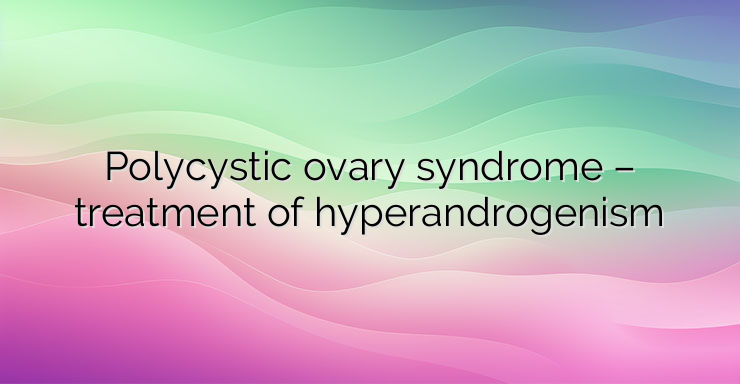One of the main symptoms of polycystic ovary syndrome (PCOS), which has a serious impact on a woman’s quality of life and self-esteem, is hyperandrogenism. It is manifested by increased hair growth, oiliness of the skin and acne, hair loss, which are a frequent reason for seeking medical help. Androgens are the hormones that determine the development of male genitalia. These are testosterone, dihydrotestosterone, androstenedione, dehydroepiandrosterone (DHEA). Androgens are responsible for male pattern baldness and male pattern baldness. The excess of male sex hormones in women leads to the appearance of male pattern baldness and hair loss. Hair growth increases in the so-called androgen-dependent areas – face, chest, abdomen, back, inner thighs. The hairs are harder and darker (terminal), as opposed to the usual sparser, downy coat. Increased hair growth in women due to hyperandrogenemia is called hirsutism. It may be expressed to varying degrees and may not affect all of the areas listed above. The evaluation of hirsutism is done using the Ferriman-Galway scale. The presence of more than 8 points on this scale means that increased terminal hair is present. Currently, the first line of therapy for hirsutism, acne and hair loss is oral contraceptives, in combination with cosmetic products. It is possible to use a group of medicines called antiandrogens. However, they carry more health risks and remain as a backup option when there is no effect or in case of intolerance to contraceptives. How do contraceptives work? They suppress the formation of androgens from the ovaries and reduce their peripheral effects on the skin and hair follicles. In order to observe the desired effect in terms of hirsutism and hair loss, the treatment should last at least 6 months. Against the background of a contraceptive, acne improves and the menstrual cycle normalizes. Women with PCOS, however, have a significantly higher risk of adverse reactions to contraceptives, especially deep vein thrombosis and pulmonary embolism. Risk factors for this condition are obesity, diabetes mellitus, smoking, which are common in women with PCOS. Other possible side effects are gallbladder disease, cardiovascular events, high blood pressure, liver damage. Therefore, it is necessary to carefully specify the risk factors before starting such therapy. Absolute contraindications for taking contraceptives are: Smoking and age over 35 years (≥ 15 cigarettes per day); Hypertension – systolic arterial pressure ≥ 160 mmHg or diastolic pressure ≥ 100 mmHg; Current or past history of venous thromboembolism; Ischemic heart disease; History of cerebrovascular accidents; Complicated valvular heart disease; Migrainous headache with focal neurological symptoms Breast cancer; Diabetes mellitus with complications – retinopathy,neuropathy and nephropathy; Severe liver cirrhosis; Tumor of the liver; When breastfeeding in the period less than 6 weeks after birth; Relative contraindications are: Smoking over 35 years of age, but less than 15 cigarettes per day; Well-controlled hypertension; Hypertension with systolic pressure between 140-159 mmHg and diastolic pressure between 90-99 mmHg; Migraine headache and age over 35 years; Symptomatic biliary disease; Mild cirrhosis; History of contraceptive-induced cholestasis; Acceptance of medications interacting with contraceptives; In the absence of an effect on hair growth after more than 6 months of treatment with a contraceptive, in combination with cosmetic products, the inclusion of an antiandrogen can be considered. These are a group of medications that directly block the effects of testosterone through its receptor. Spironolactone, finasteride and flutamide are used. Antiandrogens remain a second line of therapy because they are toxic to the liver. They must be used against the background of contraception, as they are dangerous for the fetus in the event of pregnancy. References: 1. Legro RS. Evaluation and Treatment of Polycystic Ovary Syndrome. 2017 Jan 11. Endotext [Internet]. South Dartmouth (MA): MDText.com, Inc.; 2000–. PMID: 25905194. 2. Teede HJ, Misso ML, Costello MF, Dokras A, Laven J, Moran L, Piltonen T, Norman RJ; International PCOS Network. Recommendations from the international evidence-based guideline for the assessment and management of polycystic ovary syndrome. Fertil Steril. 2018 Aug;110(3):364-379. doi: 10.1016/j.fertnstert.2018.05.004. Epub 2018 Jul 19. PMID: 30033227; PMCID: PMC6939856.Recommendations from the international evidence-based guideline for the assessment and management of polycystic ovary syndrome. Fertil Steril. 2018 Aug;110(3):364-379. doi: 10.1016/j.fertnstert.2018.05.004. Epub 2018 Jul 19. PMID: 30033227; PMCID: PMC6939856.Recommendations from the international evidence-based guideline for the assessment and management of polycystic ovary syndrome. Fertil Steril. 2018 Aug;110(3):364-379. doi: 10.1016/j.fertnstert.2018.05.004. Epub 2018 Jul 19. PMID: 30033227; PMCID: PMC6939856.


Leave a Reply